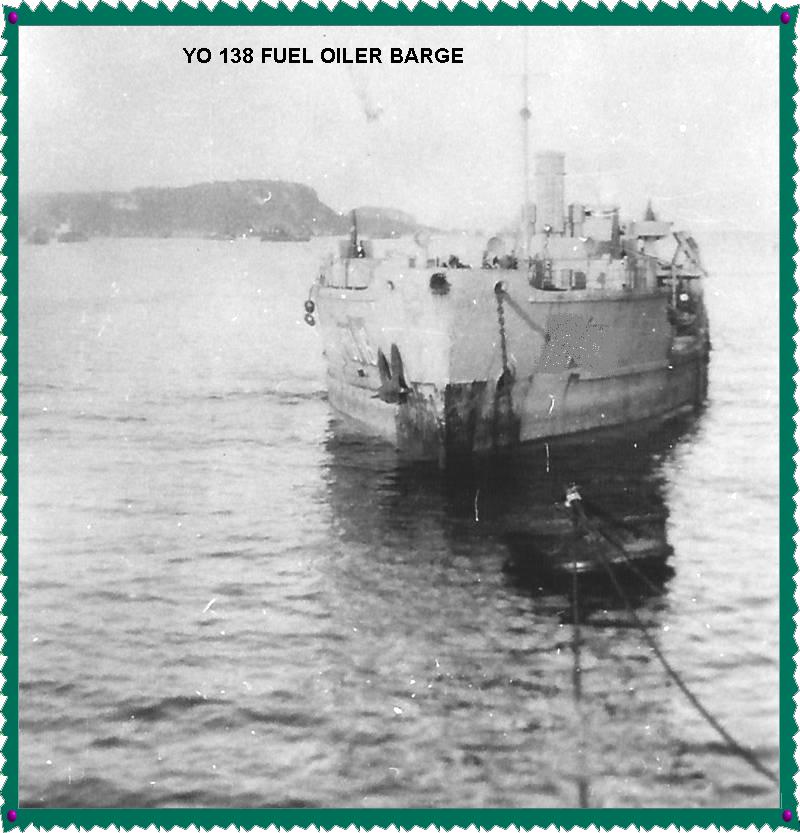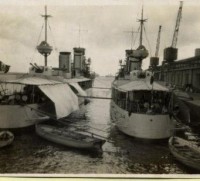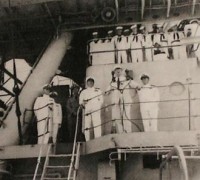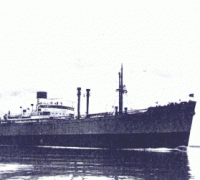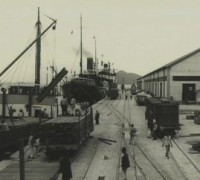- COMMANDER SOUTH ATLANTIC
13)SOLVING THE FUEL PROBLEM
One of the pressing problems of the South Atlantic War continued to be that of fuel. This had been present from the first days, and had never been satisfactorily solved. In the beginning, when the numbers of ships involved was small and when the visits made to Brazil were comparatively few, commercial companies handled the fueling. This peacetime arrangement, however, could not serve the purpose when demands increased. The next step was to fuel the ships in Brazilian ports by means of the occasional runs of the Patoka from Trinidad to Recife.
Other Tankers later engaged in this activity. But by the Summer of 1942 the size of operations, and consequently the need for fuel, had greatly increased. The Force was working on inadequate margin. Fueling capacity in Recife, which had been enough to meet the demands of 1941, was far outgrown a year later. The tanks, even when full, which they seldom were, could hold only enough for two weeks, normal operation at a given time. Included in the inadequate facilities were the two tanks belonging to the Recife Alcohol Institute, which were being temporarily utilized.
Moreover, the area had only a limited number of Tankers assigned to it, and the loss of any one; a misfortune quite likely to occur; would cripple operations severely. Loss of the Patoka; na extremeley vulnerable ship when at sea, would a tone time have been almost ruinous. A contract existed with the Caloric Oil Company, a subsidiary of the Standard Oil Company, whereby this firm would fuel or bunker ships. It would also storage fuel on a through put arrangement; in other words the company was to receive payment by the barrel.
By the Summer of 1942, Destroyers often had to be brought into Recife for a three hour “quick turnaround”, meaning that they must be fueled, supplied, and ready for sea again within three hours. The Caloric pumps did not meat the situation. Their estimated capacity was 150 tons per hour, though 125 was considered good in actual practice. At this point Lieutenant, later Lieutenant Commander C.C. Dunn came into the Picture. He reported to the Recife Naval Observer on July 16, 1942, to act as Convoy Routing Officer. He had, however, a long experience in the oil industry, having been an official of the Texas Company, with executive experience, from 1932, to 1942.
Seeing the inadequacy of existing facilities, Lieutenant Dunn suggested that the Navy at Recife build its own tanks and install pumps on its own. The Admiral approved the suggested, and Dunn, working in conjunction with an engineer of the Caloric Company, laid out a tentative tank plan, which was to utilize the real state controlled by Standard Oil of Brazil, Caloric, and the Anglo-Mexican Company.This property lay in the dock area of Recife. From the United States were ordered ten 10,000 barrel bolted tanks and six positive action fueling pumps. Washington instantly recognized the importance of this, and the need that existed.
The pumps and the unassembled tanks were quickly sent, aboard the City of Birmingham. Between Trinidad and Recife this ship received a German torpedo and sank, pumps, tanks and all. The setback was serious. It closely coincided in time with the Admiral’s removal of his flag from the Memphis to the Patoka, which meant that the latter must now be kept in Recife. But although she could no longer make the runs to Trinidad she could act as a floating storage for oil. Duplicate orders for tanks and pumps, cabled to Washington, again received prompt attention, so the delay created by the loss of the City of Birmingham finally proved less grave than might have been the case.
The materiel arrived safely this time, and the erection and placing in commisssion took place promptly. The needs of Recife having been filled, those of Bahia next received attention. The force Civil engineer erected ther two 80,000 barrel tanks, and three with a 10,000 barrel capacity. Assignment of an Area Petroleum Officer was the next step. Lieutenant Commander, later Commander, F. B. Risser, received this appointment, with his jurisdiction including all Brazil.
His business was to coordinate estimated comsumption for American Military, both Army and Navy; Brazilian Military, all branches included; and the American commercial activities in Brazil. He also had authority to make decisions regarding proposed Tanker layouts. Lieutenant Dunn became Assistant Area Petroleum Officer, with responsibility for the area from Bahia Northward. The systems worked out well. As the Tankers sailed from Trinidad, Lieutenant Dunn had authority, acting through the Operations Officer, to divert them to whatever port most needed fuel, regardless of what their original destination in the area had been.
Excellent coordination between Lieutenant Comander Risser and his Recife Assistant contributed to the result. Lieutenant Dunn, for purposes of the oil needs of the South Atlantic Force, became an ex-officio member of Admiral Ingram’s staff. By October 1942, petroleum responsibilities had become so heavy that Ensign, later Lieutenant (jg) H.B. Luckett, who was already Lieutenant Dunn’s assistant in convoy and routing, became his assistant in petroleum as well. To anticipate slightly, and to diverge from strict chronological sequence, there was in addition to the oil products problem for the ships a serious tangle in the matter of 100 octane gasoline.
This had to do with fueling the planes of both American Services and those of the Força Aerea Brasileira. Each activity hitherto had been important quantities of octane for its own requirements. This meant separate allocations, segregate storage, duplication in distribution, and in general an unhealthy overlapping. Admiral Ingram and General Walsh (Wooten), the Army Ferry Commander, were aware of the situation that existed. The former, as the senior U.S. officer in the area, took the steps needed for correcting the situation. On November 12, 1942, He issued orders necessary for coordinating gasoline and lubricating oil in Brazil.
He established a Board consisting of Lt. Dunn, senior member, Captain Thomas J. Hildt of the Army, and Tenente (Lieutenant) Colombo Guardia Filho, FAB, with Ensign Luckett as secretary. The Board should make decisions by itself on routine matters and recommendations to the Admiral on policy. It could allocate aviation gas and oil to Brazilian ports and arrange for their shipment when necessary. Only in emergencies could fuel be issued to commercial companies, such as Condor or Panair. The Board had scarcely started functioning when both Captain Hildt and Tenente Guardia Filho were detached and their services lost.
There was no Brazilian replacement, but Colonel Harris of the Army substituted for Hildt. Thereafter Dunn and Harris worked as a two man team, with Luckett continuing as secretary. Their most important decision and policy was the pooling of all 100 octane stocks in the custody of the U.S. Army. During the year of 1943, requirements for 100 octane grew by leaps and bounds, for two reasons. First, there was an enormous increase in planes ferried through Brazil, via Belem, Fortaleza and Natal, to Africa, Europe and India.
Added to this was the great expansion of anti-submarine warfare in the area, which necessitated an increase in the Navy’s plane force from one squadron in July 1942 to eight squadrons a year later. The planes, wherever they were based, had to be gassed and gassed immediately. They operated all the way from Amapa in the north, to Florianopolis in the south; even at times from Montevideo in Uruguay. Their needs taxed distribution facilities to the limit. The coordinating Board utilized every means available, and everything that would float, to carry gas where it was needed. In this hauling work, the old Fuel Oil Barge YO 138, previously the Brazilian Aurora, proved a Godsend.
Fuel Oiler Barge YO 138.
As far back as 1932, she had been condemned in Rio; now, tem years later, she was doing yeoman service, particularly in keeping the tanks of Natal supplied for their Constant task of fueling planes bound across the Atlantic. Though her hull and tanks were in bad shape at first, reffiting made her seaworthy again. At a time when Natal facilities were inadequate and the harbor undredged, the Yo 138 could make three and a half four knots against the tide, and six when the current was running astern. It later became possible to put a tanker with 45,000 barrels of gas into Natal.
This, however, was subsequent to dredging the harbor and erecting proper installations. In earlier times, the maximum for Natal was 25,000. Reserves at Recife had to be shuttled there by all available means. Any empty tanker might be loaded to 25,000 barrels and sent to Natal to await her convoy there. By the use of every possible transportation, Natal was kept in a position to fuel the vital ferry ships, on their way to the battle zones of the Old World. The advent of Lighter-than-Air craft into Brazil, in the latter part of 1943, meant that another type of fuel, 91 octane, had to be supplied. This also became the responsibility of the Coordination Board, which was frenquently hard pressed. The blimps, however, were never grounded for lack of fuel.
By the Summer of 1943, it was believed that Fortaleza would be the main jumping off place for four motored craft bound for Africa and points east. The Army and Navy, with help from Standard Oil of Brazil, erected additional bolted tanks at that Facility, to make possible bulk shipments there for both 91 and 100 octane. The matter of fuel and its distribution has been competently managed in the South Atlantic since the beginning. Those handing it from Navy side say that for 100 octane and 1120 lube oil for the Army contingent did most of the work. Therefore, they acknowledge, to the Army should go the main credit for the continued flow, excellent distribution, and fine dispensing at the various fields.
U.S. Administration in World War Two. Commander South Atlantic Force.
HyperWar - Commander South Atlantic Force. U.S. Naval Administration in WW II
